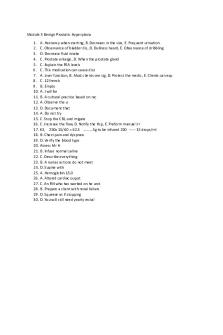Module 5 study questions PDF

| Title | Module 5 study questions |
|---|---|
| Course | Introduction to Biology |
| Institution | Western Governors University |
| Pages | 4 |
| File Size | 237 KB |
| File Type | |
| Total Downloads | 86 |
| Total Views | 150 |
Summary
Download Module 5 study questions PDF
Description
Module 5 Study Questions 1. Complete the following diagram. Be sure to include at least two functions and two examples for each macromolecule. Macromolecules What common features do all organic macromolecules have? 1. Contain carbon atoms bonded to Hydrogen (C-H bonds) 2. Often contain Oxygen, Nitrogen, Phosphorus, or Sulfur 3. Atoms are connected by covalent bonds, modular, smaller monomers can be linked to make larger polymers. Often associated w/living things. Type of Macromolecule Carbohydrate s
Nucleic Acids
Lipids
Proteins
Monomer Sugar s
nucleotides
Fatty acids
Amino acids
Functions Stores energy/provide structural support
Stores genetic info that the cell uses to control all its processes
Use long term energy storage, vital role as a part of the membrane of a cell
Important structural and communication molecule. Most important role is as enzymes-help speed up and control chemical reactions occurring in the cell
Examples Cellulose
DNA
Fats, steroids(cholesterol)oils, waxes, phospholipids
Enzymes
2. The image below is showing an oil and water mixture. Based on the chemical properties of water and lipids, explain what we see happening in the picture. The water (solvent) is
mixed with a Hydrophobic solute. The Solute (non-polar molecules) will not form a solution in water.
3. Complete the following table with the 4 types of lipids: Type of Lipid Fats and oils
Structure Glycerol and fatty acids
Phospholipids Fatty acids and phosphate
Steroids
Carbon ring molecules
Waxes
Esters of fatty acids
4. Identify A, B and C in the figure below:
Function Stores energy for use @later time Provides structure to cell membrane. A protective barrier surrounding cell or separating compartments forming organelles w/in cell. Provides structure to membranes. Regulates many developmental metabolic and energy processes. Forms protective layers on plants and animals to repel water. A= Phospholipid B=Hydrophilic Head C=Hydrophobic Tail
5. In the picture above, B is Hydrophilic, meaning that it mixes well with water, while C is Hydrophobic, meaning that doesn’t mix well with water. How does this structure allow the formation of the phospholipid bilayer in cellular membranes? They will assemble into circles, keeping water molecules away from the hydrophobic tails while keeping hydrophilic heads in contact with water.
6. What type of macromolecule is depicted in the image below? What is its function? Protein – Catalysts make a reaction go faster, help move substances, transport material, recognize specific molecules facilitate mechanical movement and maintain structure.
FLASHBACK TO MODULE 3: The image below shows a glucose molecule. As all organic molecules, it contains carbon and hydrogen atoms. In this molecule, the electrons are shared between the carbon, hydrogen, and oxygen atoms. What type of chemical bond holds these atoms together?
Covalent Bonds hold the atoms together...
Similar Free PDFs

Module 5 study questions
- 4 Pages

Module 5 Study Guide
- 14 Pages

Module 5 Study Guide
- 6 Pages

Module 5 Study Notes
- 30 Pages

Study questions week 5
- 2 Pages

Quiz 5 Study Questions
- 7 Pages

Module 5 Study Guide Lecture
- 3 Pages

Module 5 test study 2 - Mod 5
- 3 Pages

5 waves self study questions
- 27 Pages

MODULE QUESTIONS
- 2 Pages

Exam 2 Module 5-8 Study Guide
- 14 Pages

Case Study Module 5 - Grade: A
- 6 Pages

Module 5
- 5 Pages
Popular Institutions
- Tinajero National High School - Annex
- Politeknik Caltex Riau
- Yokohama City University
- SGT University
- University of Al-Qadisiyah
- Divine Word College of Vigan
- Techniek College Rotterdam
- Universidade de Santiago
- Universiti Teknologi MARA Cawangan Johor Kampus Pasir Gudang
- Poltekkes Kemenkes Yogyakarta
- Baguio City National High School
- Colegio san marcos
- preparatoria uno
- Centro de Bachillerato Tecnológico Industrial y de Servicios No. 107
- Dalian Maritime University
- Quang Trung Secondary School
- Colegio Tecnológico en Informática
- Corporación Regional de Educación Superior
- Grupo CEDVA
- Dar Al Uloom University
- Centro de Estudios Preuniversitarios de la Universidad Nacional de Ingeniería
- 上智大学
- Aakash International School, Nuna Majara
- San Felipe Neri Catholic School
- Kang Chiao International School - New Taipei City
- Misamis Occidental National High School
- Institución Educativa Escuela Normal Juan Ladrilleros
- Kolehiyo ng Pantukan
- Batanes State College
- Instituto Continental
- Sekolah Menengah Kejuruan Kesehatan Kaltara (Tarakan)
- Colegio de La Inmaculada Concepcion - Cebu


